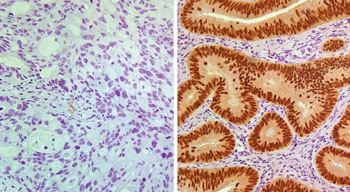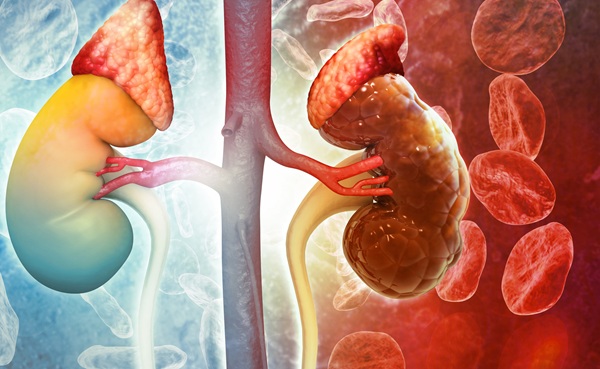Prognostic Biomarker Found for Colon Cancer Patients
|
By LabMedica International staff writers Posted on 10 Feb 2016 |

Image: Patients whose stage II colon cancer tested negative for CDX2 expression (left) had a worse prognosis than those whose cancer tested positive (right) (Photo courtesy of Columbia University Medical Center).
The majority of colon cancer patients whose tumors have started to travel to nearby tissue but no further are cured by surgery alone, but in a minority of these stage II colon cancer cases the cancer returns and the patients die.
The identification of high-risk stage II colon cancers is key to the selection of patients who require adjuvant treatment after surgery and microarray-based multigene-expression signatures derived from stem cells and progenitor cells hold promise, but they are difficult to use in clinical practice.
Scientists at the Columbia University Medical Center (New York, NY, USA) and their colleagues obtained colon-cancer tissue microarrays, fully annotated with clinical and pathological information, from three independent sources: 367 patients in the Cancer Diagnosis Program of the National Cancer Institute, 1,519 patients in the National Surgical Adjuvant Breast and Bowel Project C-07 trial, and 321 patients in the Stanford Tissue Microarray Database.
Formalin-fixed, paraffin-embedded tissue sections were stained with a mouse antihuman caudal-type homeobox transcription factor 2 (CDX2) monoclonal antibody that was previously validated for diagnostic applications (clone CDX2-88, BioGenex; Fremont, CA, USA). Tissue slides were stained on a Bond-Max automatic stainer and antigen detection was visualized with the use of the Bond Polymer Refine Detection kit (Leica Microsystems; Buffalo Grove, IL, USA). All tissue microarrays were scored for CDX2 expression in a blinded fashion and in cases in which tissue microarrays contained two tissue cores for a patient the two cores were scored independently and paired at the end.
Using a new bioinformatics approach, the team searched data from over 2,000 colon cancer patients and found 16 genes whose lack of expression is always tied to high levels of cancer stem cell markers. Of the 16 potential biomarkers, they found only one, the gene CDX2, for which a standardized test that detects its expression is already available. CDX2 regulates cell differentiation that is deciding the type of cell an immature stem cell matures into in the lining of the colon, which is where colon cancer starts. The team found that colon cancer patients whose tumors did not express CDX2 were more likely to relapse and die compared with patients whose tumors did express CDX2.
Piero Dalerba, MD, an assistant professor of medicine, pathology and cell biology, and lead author said, “We wanted to understand if the small group lacking CDX2 expression—approximately 4% of the global colon cancer population—fared poorly because of an intrinsic resistance to chemotherapy. To our surprise, we found that, on the contrary, tumors lacking CDX2 expression, despite being very aggressive from a biological point of view, also appeared to benefit from early treatment with adjuvant chemotherapy.” The study was published on January 21, 2016, in the New England Journal of Medicine (NEJM).
Related Links:
Columbia University Medical Center
BioGenex
Leica Microsystems
The identification of high-risk stage II colon cancers is key to the selection of patients who require adjuvant treatment after surgery and microarray-based multigene-expression signatures derived from stem cells and progenitor cells hold promise, but they are difficult to use in clinical practice.
Scientists at the Columbia University Medical Center (New York, NY, USA) and their colleagues obtained colon-cancer tissue microarrays, fully annotated with clinical and pathological information, from three independent sources: 367 patients in the Cancer Diagnosis Program of the National Cancer Institute, 1,519 patients in the National Surgical Adjuvant Breast and Bowel Project C-07 trial, and 321 patients in the Stanford Tissue Microarray Database.
Formalin-fixed, paraffin-embedded tissue sections were stained with a mouse antihuman caudal-type homeobox transcription factor 2 (CDX2) monoclonal antibody that was previously validated for diagnostic applications (clone CDX2-88, BioGenex; Fremont, CA, USA). Tissue slides were stained on a Bond-Max automatic stainer and antigen detection was visualized with the use of the Bond Polymer Refine Detection kit (Leica Microsystems; Buffalo Grove, IL, USA). All tissue microarrays were scored for CDX2 expression in a blinded fashion and in cases in which tissue microarrays contained two tissue cores for a patient the two cores were scored independently and paired at the end.
Using a new bioinformatics approach, the team searched data from over 2,000 colon cancer patients and found 16 genes whose lack of expression is always tied to high levels of cancer stem cell markers. Of the 16 potential biomarkers, they found only one, the gene CDX2, for which a standardized test that detects its expression is already available. CDX2 regulates cell differentiation that is deciding the type of cell an immature stem cell matures into in the lining of the colon, which is where colon cancer starts. The team found that colon cancer patients whose tumors did not express CDX2 were more likely to relapse and die compared with patients whose tumors did express CDX2.
Piero Dalerba, MD, an assistant professor of medicine, pathology and cell biology, and lead author said, “We wanted to understand if the small group lacking CDX2 expression—approximately 4% of the global colon cancer population—fared poorly because of an intrinsic resistance to chemotherapy. To our surprise, we found that, on the contrary, tumors lacking CDX2 expression, despite being very aggressive from a biological point of view, also appeared to benefit from early treatment with adjuvant chemotherapy.” The study was published on January 21, 2016, in the New England Journal of Medicine (NEJM).
Related Links:
Columbia University Medical Center
BioGenex
Leica Microsystems
Latest Molecular Diagnostics News
- Blood Biomarker Improves Early Brain Injury Prognosis After Cardiac Arrest
- Biomarkers Could Identify Patients at High Risk of Severe AKI After Major Surgery
- CLIA Test Identifies Head and Neck Cancer Recurrence from Post-Surgical Lymphatic Fluid
- New 15-Minute Hepatitis C Test Paves Way for Same-Day Treatment
- Ovarian Cancer Assay Outperforms Traditional Tests in Early Detection
- Ultrasensitive Method Detects Low-Frequency Cancer Mutations
- Blood Test Enables Non-Invasive Endometriosis Detection
- New Blood Biomarkers Help Diagnose Pregnancy-Linked Liver Complication
- Simple Urine Test to Revolutionize Bladder Cancer Diagnosis and Treatment
- Blood Test to Enable Earlier and Simpler Detection of Liver Fibrosis
- Genetic Marker to Help Children with T-Cell Leukemia Avoid Unnecessary Chemotherapy
- Four-Gene Blood Test Rules Out Bacterial Lung Infection
- New PCR Test Improves Diagnostic Accuracy of Bacterial Vaginosis and Candida Vaginitis
- New Serum Marker-Editing Strategy to Improve Diagnosis of Neurological Diseases
- World’s First Genetic Type 1 Diabetes Risk Test Enables Early Detection
- Blood Test to Help Low-Risk Gastric Cancer Patients Avoid Unnecessary Surgery
Channels
Clinical Chemistry
view channel
POC Breath Diagnostic System to Detect Pneumonia-Causing Pathogens
Pseudomonas aeruginosa is a major cause of hospital-acquired and ventilator-associated pneumonia, particularly in lung transplant recipients and patients with structural lung disease. Its ability to form... Read more
Online Tool Detects Drug Exposure Directly from Patient Samples
Doctors often rely on patient interviews and medical records to determine what medications a person has taken, but this information is frequently incomplete. People may forget drugs they used, take over-the-counter... Read moreMolecular Diagnostics
view channel
Blood Biomarker Improves Early Brain Injury Prognosis After Cardiac Arrest
After a cardiac arrest, many patients remain unconscious for days, leaving doctors and families facing uncertainty about whether meaningful recovery is possible. Current tools to assess brain damage, including... Read more
Biomarkers Could Identify Patients at High Risk of Severe AKI After Major Surgery
Acute kidney injury is one of the most common and dangerous complications after major surgery, particularly among patients in intensive care. Even mild impairment of kidney function can lead to long-term... Read more
CLIA Test Identifies Head and Neck Cancer Recurrence from Post-Surgical Lymphatic Fluid
While the lymphatic system’s critical role in metastasis has long been recognized, routine access to patient lymph has been elusive. Now, a non-invasive process can access lymph through the collection... Read moreHematology
view channel
MRD Tests Could Predict Survival in Leukemia Patients
Acute myeloid leukemia is an aggressive blood cancer that disrupts normal blood cell production and often relapses even after intensive treatment. Clinicians currently lack early, reliable markers to predict... Read more
Platelet Activity Blood Test in Middle Age Could Identify Early Alzheimer’s Risk
Early detection of Alzheimer’s disease remains one of the biggest unmet needs in neurology, particularly because the biological changes underlying the disorder begin decades before memory symptoms appear.... Read more
Microvesicles Measurement Could Detect Vascular Injury in Sickle Cell Disease Patients
Assessing disease severity in sickle cell disease (SCD) remains challenging, especially when trying to predict hemolysis, vascular injury, and risk of complications such as vaso-occlusive crises.... Read more
ADLM’s New Coagulation Testing Guidance to Improve Care for Patients on Blood Thinners
Direct oral anticoagulants (DOACs) are one of the most common types of blood thinners. Patients take them to prevent a host of complications that could arise from blood clotting, including stroke, deep... Read moreImmunology
view channelBlood Test Could Detect Adverse Immunotherapy Effects
Immune checkpoint inhibitors have transformed cancer treatment, but they can also trigger serious immune-related adverse events that damage healthy organs and may become life-threatening if not detected early.... Read more
Routine Blood Test Can Predict Who Benefits Most from CAR T-Cell Therapy
CAR T-cell therapy has transformed treatment for patients with relapsed or treatment-resistant non-Hodgkin lymphoma, but many patients eventually relapse despite an initial response. Clinicians currently... Read moreMicrobiology
view channel
Blood-Based Diagnostic Method Could Identify Pediatric LRTIs
Lower-respiratory tract infections (LRTIs) are a leading cause of illness and death worldwide, and pneumonia is the leading infectious cause of death in children under five, claiming the lives of over... Read more
Rapid Diagnostic Test Matches Gold Standard for Sepsis Detection
Sepsis kills 11 million people worldwide every year and generates massive healthcare costs. In the USA and Europe alone, sepsis accounts for USD 100 billion in annual hospitalization expenses.... Read moreRapid POC Tuberculosis Test Provides Results Within 15 Minutes
Tuberculosis remains one of the world’s deadliest infectious diseases, and reducing new cases depends on identifying individuals with latent infection before it progresses. Current diagnostic tools often... Read more
Rapid Assay Identifies Bloodstream Infection Pathogens Directly from Patient Samples
Bloodstream infections in sepsis progress quickly and demand rapid, precise diagnosis. Current blood-culture methods often take one to five days to identify the pathogen, leaving clinicians to treat blindly... Read moreTechnology
view channel
Machine Learning Models Diagnose ALS Earlier Through Blood Biomarkers
Amyotrophic lateral sclerosis (ALS) is a rapidly progressive neurodegenerative disease that is notoriously difficult to diagnose in its early stages. Early symptoms often overlap with other neurological... Read more
Artificial Intelligence Model Could Accelerate Rare Disease Diagnosis
Identifying which genetic variants actually cause disease remains one of the biggest challenges in genomic medicine. Each person carries tens of thousands of DNA changes, yet only a few meaningfully alter... Read moreIndustry
view channel
BD and Penn Institute Collaborate to Advance Immunotherapy through Flow Cytometry
BD (Becton, Dickinson and Company, Franklin Lakes, NJ, USA) has entered into a strategic collaboration with the Institute for Immunology and Immune Health (I3H, Philadelphia, PA, USA) at the University... Read more




















